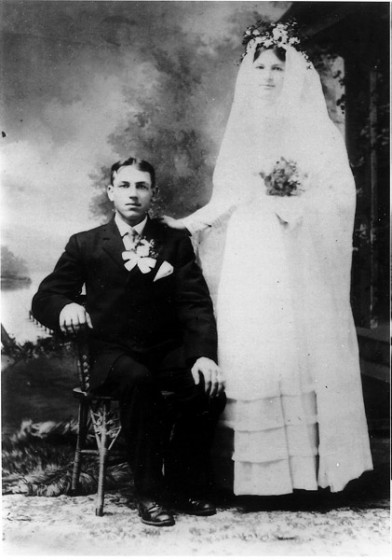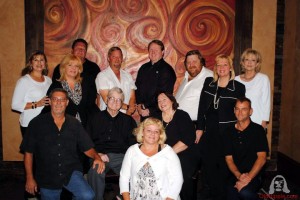 Frank & Martha Krajenka
Frank & Martha Krajenka
Carmen Castillo Schultz
June 18, 2013
This is the history of my grandmothers (and mine) family. My grandmother, Josephine Lyons (Krajenka) was the most fabulous person I ever knew. She was not educated and didn’t know how to read or write and would say things like “throw over the fence some hay”, but she was absolutely the best, most loving grandmother a person could have. I am so very proud of her (and her heritage because that is what made this beautiful woman).
Our heritage as I know it began about 1747 when my great grandfather 4 times over, Valentine Smykow was born in Legowo, Wagrowiec, Poznan, Poland. I have no information on his parents but know that in July 22, 1772 he married Marianna Bielecka, (a widow having been married to Adalbert Bielecka who died May 5, 1772). They moved to Bobrowniki Poznan, Poland where they raised their 6 children: Helena (b) April 21, 1774, Francis(b) Mar. 19, 1775, Magdalena(b) May 19, 1777, Catherine (b)Nov. 25, 1779 Dorothy(b) Feb. 5, 1785 and Thomas (b)Dec. 22, 1788.
My great, great, great grandfather Martin Beim was born 1773 and at 23 married Catherina Smyczanka (who was only 17) on Nov. 25, 1796. He was from Tarnowo and she was from Bobrowniki where they resided. Bobrowniki is just west of Wagrowiec and their church was Legowo. They had 12 children (5 boys and 7 girls). Lawrence was the eldest born Aug. 1798. Then there was Simon Oct. 26, 1800, Agnes Jan 17, 1803, Catherina Oct. 10, 1805, Peter Feb. 16, 1808, Andrew Nov. 21, 1810, twins Julianna and Eva Rosalia Feb,. 1814, Appolonia Marianna (who died June 15, 1816),Marianna Jun. 16, 1817, Helen April 26, 1819 and Valentine Feb. 12, 1822. Catherina died July 30, 1843 (at 64) and Martin died two years later (1845.
My great, great grandfather was Martin Krajenka born 1801. He married Agnes (Beim) Janowiak on May 20, 1830. Agnes was the widow of Michael Janowiak and the daughter of Martin and Catherina (Smyczanka) Beim from the village of Bobrowniki, Wagrowiec, Poznan, Poland. Martin was from Bartodzieje. They lived in Legowo which is just SW of Wagrowiec in the area of Poznan, Poland. They had 5 children, Francisca Sept. 26, 1833, John May 11, 1836, Josepha Mar. 13, 1839, Peter Sep. 2, 1842 but died 4 months later on Jan 7, 1843 and the youngest Martin, Oct. 11, 1844. Agnes died 4 years later on Jun. 28, 1847.
Martin married Magdalene Skorynaka though the record of their marriage was not found in Legowo. 6 more children were born to them bringing the children in the family to 11. Maria (b) Aug 30, 1848, Anna (b) Jun 16, 1850, Simon about 1854, Valentina abt. 1858, Joseph (b) about 1860 and Michael (b) abt. 1863. Baptism’s of the Martin’s children in Legowo end with Anna. It was told to Martin’s great grandson John that Magdalene’s family caused Martin to lose his farm. They may have left Legowo. No record was found that Martin immigrated. It’s believed he died in Poland before 1881, when Magdalene and son Michael immigrated. They sailed on the ship Helca from Antwerp to New York arriving June 14, 1881.
My Great grandfather John Krajenka was the son of Martin and Agnes (Beim) and was born in Legowo, Wagrowiec, Poznan, Poland on May 11, 1836. He was baptized in Legowo on May 13, 1836 In Poland John’s wife died before 1870. Believed to have died during childbirth and there are no known children by that marriage. John married Frances Swyda about 1870 in Poland. My great grandparents John and Frances Krajenka left from the ports of Hamburg-Havre on the ship Holstia arriving in New York on June 5, 1872. This was a difficult time for the Polish people as so much was destroyed and so many young men were forced into armed service by different nations taking them over. In the second half of the 17th century and most of the 18th, Pozna? was severely affected by a series of wars (and attendant military occupations, lootings and destruction) – the Second and Third Northern Wars, the War of the Polish Succession, the Seven Years’ War and the Bar Confederation rebellion. It was also hit by frequent outbreaks of plague, and by floods, particularly that of 1736, which destroyed most of the suburban buildings. The population of the conurbation declined (from 20,000 around 1600 to 6,000 around 1730), and Bambergian and Dutch settlers (Bambrzy and Ol?drzy) were brought in to rebuild the devastated suburbs. In 1778 a “Committee of Good Order” was established in the city, which oversaw rebuilding efforts and reorganized the city’s administration. However in 1793, in the Second Partition of Poland, Pozna?, came under the control of the Kingdom of Prussia, becoming part of (and initially the seat of) the province of South Prussia.
The Prussian authorities expanded the city boundaries, making the walled city and its closest suburbs into a single administrative unit. Left-bank suburbs were incorporated in 1797, and Ostrów Tumski, Chwaliszewo, ?ródka, Ostrówek and ?acina (St. Roch) in 1800. The old city walls were taken down in the early 19th century, and major development took place to the west of the old city, with many of the main streets of today’s city centre being laid out.
In the Greater Poland Uprising of 1806, Polish soldiers and civilian volunteers assisted the efforts of Napoleon by driving out Prussian forces from the region. The city became a part of the Duchy of Warsaw in 1807, and was the seat of Pozna? Department – a unit of administrative division and local government. However in 1815, following the Congress of Vienna, the region was returned to Prussia, and Pozna? became the capital of the semi-autonomous )Grand Duchy of Posen.
So many families were moving away to get away from all the wars and fighting. This is why my great grandparents decided to move to America.
The only way to get there was by ship which was dangerous and long. The decision was usually based on economics and time allowances. The indirect route to begin with was cheaper but took more time and more inconveniences because of the stops and transfers. It was hard to continually carry belongings from ship to train to ship, etc. Yet for many emigrants it was more important to find the cheapest route than the inconveniences involved.
The choice of whether to go direct or indirect also changed over time with the introduction of the steam ships. During the 1700s everyone went by way of sailing ships. The journey could take between 3 weeks and 3 months depending on weather conditions. If the wind stopped blowing they could be stuck for extended periods of time on the ocean. With time, sailing ships improved and perfected their routes and schedules.
Immigrants from Poland, southern Germany, notably Baden, Württemberg, and Bavaria (Bayern) often took a train to the port of La Havre and left from there for the new world. This is what my great grandparents did. The trip was long but uneventful. They felt blessed to touch land again though. There they started a new life and a family which included my precious grandmother Josephine.
John and Frances resided from 1872 through 1891 at the address: 93 Illinois, in Detroit, Michigan and went to St. Albertus Catholic Church there in Detroit, Michigan. They had 6 children, my grandmother was the only girl. Michael was first born Nov 1871 but died May 17, 1873. Maximillan was born Oct. 12, 1873, Vincent Dec. 25, 1875, Peter Sept. 5, 1878, my grandmother Josephine Feb. 22, 1882 and Frank (her favorite and the youngest brother) Oct. 24, 1885.
Frances died Jan. 26, 1890 and was buried from St. Albertus in Mt. Elliott Cemetery. That means that Maximillan was 17 years old, Vincent, 2nd. oldest was 15, Peter 12 years old, my grandmother Josie was 8 years old and little Frank the youngest was only 5. It is understandable why John re-married only 4 months later but it was very difficult to have a new woman move in so shortly after their mothers’ death. This was Johns 3rd marriage having now been widowed twice. John is said to have worked on the building of St. Josehat’s School. He married Katherine Rafalska on May 5, 1890 at St. Josephat’s Detroit Michigan and had one more son John born Feb. 22, 1891 They may have had two additional children but none survived.
In 1891 John moved his family from Detroit to a farm near his half-brother, Simon, in Dwight Twp., Huron City, Mi. They still have the farm at the thumb of Michigan. In 1909 John sold the farm to his son Frank and moved with Katie to a home in Port Austin, Mi. John died Jan. 24, 1912 and is buried in St. Michael’s Cemetery, Port Austin and Katie died Feb. 11, 1937 and is also buried at St. Michael’s.
Josephine Agnes Krajenka was born Feb. 22, 1882 and died July 15, 1959. She married Guy Andrew Lyons( born Nov.5, 1876 in Plymouth Mi.) on April 25,1903 in Detroit Michigan. Guy died June 25, 1946 in an automobile accident. That is when my grandma sold our treasured lake house at Runyan Lake and came to live with us. They had two children Frank Harold Lyon (b) Feb 22, 1904 and Frances Mary Lyon (Krajenka). Josie (as my grandfather called her) also raised two grandsons Howard (Franks son) and Noel (Frances son) plus as a general rule had the rest of the Castillo grandchildren with her for summer vacation three months out of the year. She was one fantastic person and one outstanding grandmother.
Frances Mary Lyon (Krajenka) (b) May 14, 1908 married (1)Noel Mitchell Francis Sr. (b) 1890 on the Passamaquoddy (meaning People of the Dawn) Indian Reservation near E Port Maine. Noel died March 25-65. 1 son Noel M. Francis Jr.(b)July 2, 1927 (2)Francis married Ralph Maria Castillo (Ralph was born March 8, 1901 in Caracas, Venezuela, South America) Ralph had son Luis by previous marriage. Louis lived in the U.S until in his late teens he got into trouble and was deported to Caracas, Venezuela, S.A. Carmen received a letter from him after her engagement photo was published about 1953, congratulating her and stating that he was married and had three little girls. Rumor had it that he died before 1970. Ralph had 2 children with Frances, Carmen Luisa Castillo (b) April 22, 1935 in Detroit, Mi. and Ralph Guy Castillo (b) Jan 1, 1937 in Detroit, Mi. Our father, Ralph Maria died Sept. 30, 1973 and our mother, Frances died Dec. 16, 1978. Ralph and Frances are buried in Fenton, Michigan next to Guy and Josephine Lyon at St. Johns Catholic Church. My eldest brother Noel is also buried there.




